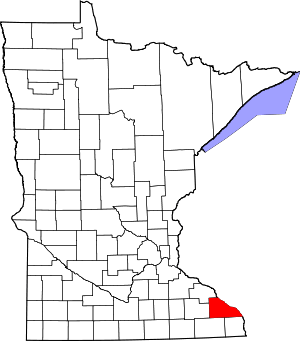Winona, Minnesota
Winona is a city in and the county seat of Winona County, in the state of Minnesota.[7] Located in picturesque bluff country on the Mississippi River, its most noticeable physical landmark is Sugar Loaf. The city is named after legendary figure Winona, said to have been the first-born daughter of Chief Wapasha (Wabasha) III.[8] The total population of the city was 27,592 at the time of the 2010 census.
Winona | |
|---|---|
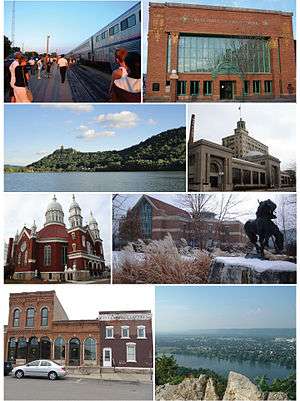 Clockwise from top-left: the Empire Builder at Winona station, Merchants National Bank, Sugar Loaf, Watkins Incorporated, Basilica of St. Stanislaus, Krueger Library, East Second Street Historic Commercial District, and Garvin Heights City Park. | |
| Nickname(s): The Island City[1] | |
 | |
| Coordinates: 44°3′N 91°38′W | |
| Country | United States |
| State | Minnesota |
| County | Winona |
| Government | |
| • Type | Mayor - Council |
| • Mayor | Mark F. Peterson |
| Area | |
| • Total | 24.32 sq mi (62.98 km2) |
| • Land | 19.03 sq mi (49.29 km2) |
| • Water | 5.29 sq mi (13.70 km2) |
| Elevation | 655*–1,247** ft (200*–380** m) |
| Population | |
| • Total | 27,592 |
| • Estimate (2019)[4] | 26,594 |
| • Density | 1,397.48/sq mi (539.56/km2) |
| Time zone | UTC−6 (CST) |
| • Summer (DST) | UTC−5 (CDT) |
| ZIP codes | 55987 |
| Area code(s) | 507 |
| FIPS code | 27-71032[5] |
| GNIS feature ID | 0654269[6] |
| Website | City of Winona |
| |
History

The city of Winona began on the site of a Native American village named Keoxa. The seat of the Wapasha dynasty, Keoxa was home to a Mdewakanton band of the eastern Sioux.
Non-Native Americans settled the area in 1851 and laid out the town into lots in 1852 and 1853. The original settlers were Yankee immigrants from New England.[9][10] The population increased from 815 in December, 1855, to 3,000 in December, 1856. In 1856 German immigrants arrived as well.[10] The Germans and the Yankees worked together planting trees and building businesses based on lumber, wheat, steamboating and railroads. Between 1859 and 1900, some 5,000 Poles and closely related Kashubians emigrated to Winona, making up one quarter of the population. Since 80% of them were Kashubians, Winona became known as the "Kashubian Capital of America". As a result of the influx of Polish Catholic immigrants, the Church of St. Stanislaus (now Basilica of St. Stanislaus Kostka) was built.[11] For a time, Winona had more millionaires than any other city of its size in the United States.[10]
The railroad and steamboat transportation industries helped Winona grow into a small city that diversified into wheat milling, and lumber production. In 1856, more than 1,300 steamboats stopped at Winona. The Winona and St. Peter Railroad first segment of 11 miles (18 km) from Winona to Stockton, Minnesota was completed by the end of 1862. Winona then had the second operational railroad in Minnesota, after the St. Paul and Pacific Line from Saint Paul to St. Anthony Falls.[12] In December 1870, the Mississippi River was bridged at Winona by the Winona Rail Bridge.[13] In 1892, a wagon toll-bridge over the Mississippi, a steel high-bridge, was completed and remained in service until the opening of the Main Channel Bridge in 1942.
Winona has two historic districts listed on the National Register of Historic Places that combine into a single local historic district administered by the city's Heritage Preservation Commission.
A bandshell was completed in 1924 for outdoor musical performances and events.[14] The Winona Municipal Bands holds concerts there during the summer.
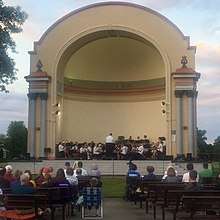
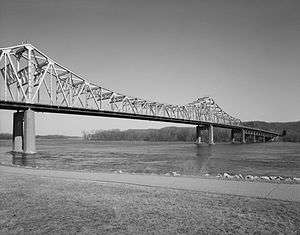
Geography
According to the United States Census Bureau, the city has a total area of 24.13 square miles (62.50 km2); 18.84 square miles (48.80 km2) is land and 5.29 square miles (13.70 km2) is water.[15] Lock and Dam 5A spans the Mississippi River in Winona. The highway bridge connecting Winona to the Wisconsin side of the river is at approximately River Mile 726 (USACE map 31[16]).
Winona's primary suburbs are Goodview, Stockton, Minnesota City and Rollingstone to the west, Homer to the southeast and Bluff Siding is 3 miles directly across the interstate bridge to the north and Fountain City to the north. Rochester is 44 miles to the west of Winona, La Crescent is 21 miles to the south, and La Crosse is 30 miles to the southeast.
Winona is part of the driftless area that includes southeastern Minnesota, northeastern Iowa, southwestern Wisconsin and northeastern Illinois.
Climate
Winona's weather station records the warmest climate of any in Minnesota, with a normal year-round average (1971–2000) temperature of 48.9 °F, (9.38 C°)"Temperature Summary Station: 219067 WINONA, MN,1971–2000 NCDC Normals". Historical Climate Data. Retrieved 2007-12-16. compared to 43.2° (6.22 C°) in Austin to the city's southwest or 45.4° (7.44 C°) in Minneapolis, to the northwest, which experiences a strong urban heat island effect. Temperatures are generally very mild by Minnesota standards year-round; the January mean is 17.6° (-8 C°), while that of July is 75.8° (24.33 C°).
| Climate data for Winona, Minnesota (1981–2010, snowfall and extremes 1893-present) | |||||||||||||
|---|---|---|---|---|---|---|---|---|---|---|---|---|---|
| Month | Jan | Feb | Mar | Apr | May | Jun | Jul | Aug | Sep | Oct | Nov | Dec | Year |
| Record high °F (°C) | 64 (18) |
73 (23) |
84 (29) |
96 (36) |
107 (42) |
106 (41) |
108 (42) |
103 (39) |
102 (39) |
93 (34) |
84 (29) |
65 (18) |
108 (42) |
| Average high °F (°C) | 27.8 (−2.3) |
32.4 (0.2) |
44.5 (6.9) |
60.5 (15.8) |
72.0 (22.2) |
80.6 (27.0) |
84.6 (29.2) |
82.3 (27.9) |
74.4 (23.6) |
61.1 (16.2) |
44.5 (6.9) |
30.1 (−1.1) |
57.9 (14.4) |
| Average low °F (°C) | 10.4 (−12.0) |
15.3 (−9.3) |
26.1 (−3.3) |
39.2 (4.0) |
50.3 (10.2) |
59.7 (15.4) |
64.4 (18.0) |
62.5 (16.9) |
54.1 (12.3) |
41.6 (5.3) |
29.0 (−1.7) |
15.4 (−9.2) |
39.0 (3.9) |
| Record low °F (°C) | −35 (−37) |
−33 (−36) |
−28 (−33) |
4 (−16) |
21 (−6) |
35 (2) |
43 (6) |
33 (1) |
25 (−4) |
7 (−14) |
−11 (−24) |
−27 (−33) |
−35 (−37) |
| Average precipitation inches (mm) | 1.17 (30) |
1.00 (25) |
1.93 (49) |
3.76 (96) |
3.86 (98) |
4.29 (109) |
4.21 (107) |
5.11 (130) |
3.93 (100) |
2.06 (52) |
2.43 (62) |
1.37 (35) |
35.12 (893) |
| Average snowfall inches (cm) | 10.09 (25.6) |
7.78 (19.8) |
8.58 (21.8) |
1.74 (4.4) |
0.05 (0.13) |
0.00 (0.00) |
0.00 (0.00) |
0.00 (0.00) |
0.00 (0.00) |
0.24 (0.61) |
3.24 (8.2) |
8.92 (22.7) |
40.64 (103.24) |
| Source 1: Western Regional Climate Center (Average Minimums/Maximums 1981–2010)[17] | |||||||||||||
| Source 2: The Weather Channel (extreme temps) [18] | |||||||||||||
Micropolitan area
The United States Office of Management and Budget has designated Winona as the principal city of the Winona, MN Micropolitan Statistical Area (µSA).[19]
Demographics
| Historical population | |||
|---|---|---|---|
| Census | Pop. | %± | |
| 1860 | 2,464 | — | |
| 1870 | 7,192 | 191.9% | |
| 1880 | 10,208 | 41.9% | |
| 1890 | 18,208 | 78.4% | |
| 1900 | 19,714 | 8.3% | |
| 1910 | 18,583 | −5.7% | |
| 1920 | 19,143 | 3.0% | |
| 1930 | 20,850 | 8.9% | |
| 1940 | 22,490 | 7.9% | |
| 1950 | 25,031 | 11.3% | |
| 1960 | 24,895 | −0.5% | |
| 1970 | 26,438 | 6.2% | |
| 1980 | 25,075 | −5.2% | |
| 1990 | 25,399 | 1.3% | |
| 2000 | 27,069 | 6.6% | |
| 2010 | 27,592 | 1.9% | |
| Est. 2019 | 26,594 | [4] | −3.6% |
| U.S. Decennial Census[20] 2018 Estimate[21] | |||
2010 census
As of the census[3] of 2010, there were 27,592 people, 10,449 households, and 5,022 families residing in the city. The population density was 1,464.5 inhabitants per square mile (565.4/km2). There were 10,989 housing units at an average density of 583.3 per square mile (225.2/km2). The racial makeup of the city was 93.0% White, 1.9% African American, 0.3% Native American, 2.9% Asian, 0.5% from other races, and 1.3% from two or more races. Hispanic or Latino of any race were 1.7% of the population.
There were 10,449 households of which 20.7% had children under the age of 18 living with them, 36.4% were married couples living together, 8.5% had a female householder with no husband present, 3.2% had a male householder with no wife present, and 51.9% were non-families. 35.6% of all households were made up of individuals and 12.6% had someone living alone who was 65 years of age or older. The average household size was 2.24 and the average family size was 2.84.
The median age in the city was 26.7 years. 14.4% of residents were under the age of 18; 33.2% were between the ages of 18 and 24; 18.5% were from 25 to 44; 20.5% were from 45 to 64; and 13.3% were 65 years of age or older. The gender makeup of the city was 47.3% male and 52.7% female.
2000 census
As of the census[5] of 2000, there were 27,069 residents. The population density was 1,485.0 people per square mile (573.3/km2). There were 10,666 housing units at an average density of 585.1 per square mile (225.9/km2). The racial makeup of the city was 94.47% White, 1.13% African American, 0.23% Native American, 2.65% Asian, 0.01% Pacific Islander, 0.47% from other races, and 1.03% from two or more races. Hispanic or Latino of any race were 1.35% of the population.
Ancestries: German (43.2%), Norwegian (15.5%), Polish (14.8%), Irish (13.0%), English (5.5%), French (3.6%).
There were 10,301 households out of which 23.9% had children under the age of 18 living with them, 40.4% were married couples living together, 8.4% had a female householder with no husband present, and 48.3% were non-families. 35.2% of all households were made up of individuals and 12.8% had someone living alone who was 65 years of age or older. The average household size was 2.27 and the average family size was 2.94.
In the city, the population was spread out with 18.0% under the age of 18, 27.5% from 18 to 24, 22.2% from 25 to 44, 18.0% from 45 to 64, and 14.2% who were 65 years of age or older. The median age was 29 years. For every 100 females, there were 88.7 males. For every 100 females age 18 and over, there were 85.1 males.
The median income for a household in the city was $32,845, and the median income for a family was $48,413. Males had a median income of $31,047 versus $23,302 for females. The per capita income for the city was $16,783. About 6.5% of families and 17.3% of the population were below the poverty line, including 11.5% of those under age 18 and 10.7% of those age 65 or over.
Transportation

U.S. Highway 14, U.S. Highway 61, Minnesota Highway 43 and Wisconsin State Highway 54 are the main routes into the city. Interstate Highway 90 is located a short distance south of the city.
Winona was once served by four railroads; Milwaukee Road (CMStP&P), Chicago & Northwestern (C&NW), Chicago Great Western (CGW) and Green Bay & Western (GB&W), with the Burlington Route (CB&Q) trains stopping at a station across the river in Wisconsin. Only the former Milwaukee Road station remains and is now served by Amtrak's Empire Builder daily in each direction between Chicago and Seattle and Portland. The Milwaukee Road is now Canadian Pacific, as is the Dakota, Minnesota & Eastern, which operates the former Chicago & North Western line from Winona to the west.
Winona Municipal Airport - Max Conrad Field serves general aviation in the area. It was once served by one passenger airliner, Mississippi Valley Airlines until the mid-1970s.
Economy
Winona is home to the headquarters of the Watkins Corporation, Fastenal, Thern Inc., Knitcraft Corporation, RTP Company, We-No-Nah Canoe,[23] United Building Centers, Badger Equipment Company,[24] Winona Lighting, WinCraft Sports, and Winona Pattern & Mold.[25] Bay State Milling operates a grain processing facility in Winona and was founded there in 1899.
Winona is also known as the stained glass capital of the United States.[26] Winona is the setting of the Civil War era romance novel, Ladyslipper by Winona native, Donna G. Weber (1951–2012).[27]
Top employers
According to the City's 2011 Comprehensive Annual Financial Report,[28] the top employers in the city are:
| # | Employer | # of Employees |
|---|---|---|
| 1 | Fastenal | 1,420 |
| 2 | Winona Health | 1,200 |
| 3 | TRW Automotive Electronics | 775 |
| T-4 | Independent School District 861 | 712 |
| T-4 | Winona State University | 712 |
| 6 | WinCraft | 420 |
| 7 | Saint Mary's University of Minnesota | 391 |
| 8 | RTP | 375 |
| 9 | County of Winona | 291 |
| 10 | Watlow Electric Manufacturing Company | 290 |
Government and politics
Winona is located in Minnesota's 1st congressional district, represented by Jim Hagedorn, a Republican. Hagedorn was elected to office in November 2018. At the state level, Winona is located in Senate District 28, represented by Republican Jeremy Miller, and in House District 28A, represented by Democrat Gene Pelowski. Nearby House District 28B is represented by Greg Davids, a Republican. Mark Peterson is mayor.[29]
Education

Winona became the site of the first normal school west of the Mississippi in 1858 with the establishment of Winona Normal School (now Winona State University). This was the beginning of Winona's tradition as a center of higher education. In 2018-2019, Winona State University (WSU) had approximately 7,200 undergraduate students and 560 graduate students.[30] WSU is part of the Minnesota State college system.[31]
Saint Mary's College (now Saint Mary's University) was founded as a private Catholic, Lasallian school in 1912. Later, as the necessary opportunity of higher education for women became apparent, the College of Saint Teresa was created. After Saint Mary's became co-ed in 1969, Saint Teresa closed down in 1988, and its facilities are now used, owned, and/or operated by Saint Mary's University of Minnesota, Winona State University, and Cotter High School. Minnesota State College-Southeast also has a campus in Winona.
There is also a relatively diverse variety of K-12 educational opportunities. Run by Independent School District 861, the local public school system includes five elementary schools (three in the city of Winona), the Winona Middle School, and the Winona Senior High School. The Winona Area Catholic Schools system includes St. Mary's primary school, St. Stanislaus Elementary School, Cotter Junior High School, and Cotter Senior High School. There are also other non-preparatory private schools. Bluffview Montessori Charter School, located in Winona, was the first charter Montessori, and the second charter school overall in the United States. There are also two private Lutheran K-8 schools, and Hope Lutheran High School.
Media

Winona has two newspapers: the Winona Daily News, a daily morning paper; and the Winona Post, a semi-weekly paper with mid-week and Sunday editions. Papers from La Crosse, Rochester, and the Twin Cities are also commonly read.
- Television
Winona receives TV signals from neighboring cities, including several channels each from La Crosse, Rochester, Eau Claire, and the Twin Cities, although what can be received depends on the location within the area, as the extensive system of valleys and ridges may block any or all signals. There is one local public broadcasting TV network, HBCI, which is available only to subscribers of the HBC cable company.
- Radio
FM
| FM radio stations | ||||
|---|---|---|---|---|
| Frequency | Call sign | Name | Format | Owner |
| 88.5 FM | K203BR (KFSI Translator) | Christian | Faith Sound Incorporated | |
| 89.5 FM | KQAL | College | Winona State University | |
| 92.5 FM | KSMR | College | Saint Mary's University of Minnesota | |
| 94.3 FM | K232CZ (KSMR Translator) | College | Saint Mary's University of Minnesota | |
| 95.3 FM | KGSL | KG-95.3 | Hot AC | Leighton Broadcasting |
| 98.7 FM | W274BW (KWNO-AM Translator) | News/Talk | Leighton Broadcasting | |
| 99.3 FM | KHWK | 99.3 The Hawk | Country | Leighton Broadcasting |
| 101.1 FM | KRIV | 101.1 The River | Classic Hits | Leighton Broadcasting |
| 101.9 FM | K270AB (KZSE Translator) | MPR News | Public Radio | Minnesota Public Radio |
| 103.9 FM | K280EL (KQYB Translator) | KQ98 | Country | Family Radio, Inc. |
| 107.3 FM | W297AW (KLSE Translator) | Classical MPR | Classical | Minnesota Public Radio |
AM
| AM radio stations | ||||
|---|---|---|---|---|
| Frequency | Call sign | Name | Format | Owner |
| 1230 AM | KWNO | News/Talk | Leighton Broadcasting | |
| 1380 AM | KHWK | Country | Leighton Broadcasting | |
Notable people
- Carol Bartz, former CEO of Yahoo!, formerly of Autodesk
- Charles H. Berry, first Attorney General of Minnesota
- Bernhard Brenner, Founder/President of Knitcraft Corporation, manufacturer of St. Croix luxury knitwear.
- Paul Breza, Roman Catholic priest and founder of Winona's Polish Cultural Institute and Museum
- Robert Henry Brom, Roman Catholic bishop
- Alec Brown, NBA player
- Elliott Heath, distance runner
- Garrett Heath, distance runner
- Roger Busdicker, co-founder of Hal Leonard Corporation
- Jan Romuald Byzewski OFM, pastor of Saint Stanislaus Kostka Parish and founder of the Polish-language newspaper Wiarus
- Tracy Caulkins, swimmer, three-time Olympic gold medalist
- Max Conrad, aviator
- James Earle Fraser (1876–1953), sculptor, designer of the Buffalo Nickel and the "End of the Trail" statue
- Paul Giel, athlete, two-time Big Ten Player of the Year, member of College Football Hall of Fame
- Mabel Farrington Gifford, expert on speech defects and disorders
- James "J. R." Keller, state senator and representative
- Bob Kierlin, businessman and politician
- John G. McMynn, Wisconsin Superintendent of Public Instruction
- William D. Mitchell, United States Attorney General under presidents Calvin Coolidge and Herbert Hoover
- Thomas H. Moodie, North Dakota governor
- Anne Pellowski, author, educator, and Kashubian American activist, received her high school education in Winona and lived there upon retirement.
- Benjamin H. Randall, American politician and businessman, early settler to Minnesota Territory.
- Winona Ryder, actress (Despite rumors of being born in nearby Olmsted country, Winona Ryder herself has confirmed she was born in Winona)
- Orlando Stevens, member of the state legislatures of both Vermont and Minnesota[32]
- Eleanor Joy Toll, Los Angeles-area educator and clubwoman
- Joseph Ray Watkins, was a citizen and an entrepreneur and founder of Watkins Incorporated.
- Julie Wera, infielder with 1927 New York Yankees
- William Windom, actor, and his great grandfather, politician William Windom (1827–1891), who served as a Republican member of both the U.S. House of Representatives and U.S. Senate from Minnesota; later became Secretary of the Treasury under presidents James Garfield, Chester Arthur and Benjamin Harrison; the actor William Windom's character of "Glen Morley" in The Farmer's Daughter television series (1963) was also a congressman from Minnesota
- Gregg L. Witt, is an American author, youth brand strategist, speaker, and former professional skateboarder. Witt is known for his youth marketing strategies, keynote talks, seminars, and business book, The Gen Z Frequency published by Kogan Page. In 2016 he was named a top 5 youth marketer to follow by Inc. Magazine and in 2017 he made the Forbes list of leading Generation Z experts.[33][34]
- Cat Zingano, mixed martial artist
- “The Real Deal” Chris Steel, professional wrestler
- Eugenia Wheeler Goff (1844-1922), historian, cartographer, educator, and author
Sister cities


- Winona Sister-City Website
Landmarks
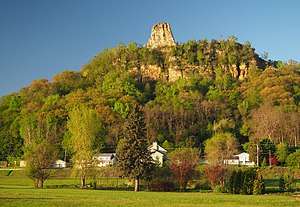
- Sugar Loaf is river bluff topped by a distinctive rock pinnacle, which was left after quarrying activity in the 19th century. It is located at the junction of Highway 61 and Highway 43/Mankato Avenue.[36]
- Basilica of Saint Stanislaus Kostka is a historic Catholic church built in 1895 in the Polish Cathedral Style.
- Lake Winona is separated from the Mississippi River by downtown Winona. It is surrounded by a park, which contains the Winona Lake Park Bandshell and a recreation center.[37]
- Garvin Heights City Park is an overlook of the Mississippi River that is used to view a panorama of the city and surrounding area.[38]
References
- "Background Information – City of Winona's Evolution" (PDF). Opportunity Winona. Port Authority of Winona. November 3, 2016. Retrieved 2016-12-29.
Known as the Island City, Winona...
- "2019 U.S. Gazetteer Files". United States Census Bureau. Retrieved July 26, 2020.
- "U.S. Census website". United States Census Bureau. Retrieved 2012-11-13.
- "Population and Housing Unit Estimates". United States Census Bureau. May 24, 2020. Retrieved May 27, 2020.
- "U.S. Census website". United States Census Bureau. Retrieved 2008-01-31.
- "US Board on Geographic Names". United States Geological Survey. 2007-10-25. Retrieved 2008-01-31.
- "Find a County". National Association of Counties. Retrieved 2011-06-07.
- Porter, Cynthya (February 1, 2009). "Homecoming To Explore Roles Of American Indian Women". Winona Daily News reprinted at Diversity Foundation. Retrieved 21 Oct 2015.
- Walter Bennick (2012). Winona. Arcadia Publishing. ISBN 978-0-7385-9425-5.
- Minnesota: A State Guide page 263
- "Kashubian Capital of America – Bambenek.org". bambenek.org. Retrieved 2017-07-21.
- Daniel R. Pratt, Andrew J. Schmidt, Andrea C. Vermeer, and Betsy H. Bradley - Railroads in Minnesota, 1862-1956 MPS. United States Department of the Interior, National Park Service. Aug 2002, St. Paul, MN Section E. Statement of Historic Contexts - I. Railroad Development in Minnesota, 1862-1956
- Hubbard, Lucius F. (1908). Minnesota in Three Centuries: 1655-1908 1870. Publishing Society of Minnesota. pp. 359–.
- "The Winona Lake Park Bandshell". Winona Municipal Band. 2015-07-14. Retrieved 2019-02-15.
- "US Gazetteer files 2010". United States Census Bureau. Archived from the original on 2012-01-25. Retrieved 2012-11-13.
- "Upper Mississippi River Navigation Charts". www.mvr.usace.army.mil. Retrieved 2019-01-09.
- "WINONA, MINNESOTA - Climate Summary". Western Regional Climate Center. Archived from the original on 7 July 2015. Retrieved July 3, 2015.
- "Monthly Averages for Winona, MN (55987)". The Weather Channel. Retrieved 2016-03-20.
- "OMB Bulletin No. 13-01: Revised Delineations of Metropolitan Statistical Areas, Micropolitan Statistical Areas, and Combined Statistical Areas, and Guidance on Uses of the Delineations of These Areas" (PDF). United States Office of Management and Budget. February 28, 2013. Retrieved April 1, 2013.
- United States Census Bureau. "Census of Population and Housing". Retrieved October 28, 2014.
- "Population Estimates". United States Census Bureau. Retrieved June 8, 2018.
- Portrait and Biographical Record of Winona County, Minnesota: Containing Biographical Sketches of Prominent and Representative Citizens of the County. Chapman Brothers. 1895. pp. 417.
james hennessy.
- "We-No-Nah Canoe".
- "Badger Equipment Company".
- "Winona Pattern & Mold".
- Cathy Wurzer (26 November 2006). "Winona company makes glass into art". publicradio.org.
- Weber, Donna G. Ladyslipper. CreateSpace Independent Publishing Platform. ISBN 9781479225880.
- "City of Winona, Minnesota Comprehensive Annual Financial Report for the Year Ended December 31, 2011" (PDF).
- "Mayor & City Council".
- "About WSU".
- "Minnesota State".
- Crafts, James M.; Crafts, William Francis (1893). The Crafts Family: A Genealogical and Biographical History of the Descendants of Griffin and Alice Craft of Roxbury, Mass., 1630-1890. Northampton, MA: Gazette Printing Company. p. 224.
- Pozin, llya (2016-09-27). "The Top 11 Youth Marketers to Follow This Year". Inc. Retrieved 2018-09-03.
- Patel, Deep (2017-04-06). "10 Gen Z Experts You Should Be Following". Forbes. Retrieved 2018-09-03.
- "Miasta Partnerskie". Bytów City Council Official Site (in Polish). Archived from the original on 2013-05-03. Retrieved 2013-06-22.
- Zellie, Carole (1989-05-31). "National Register of Historic Places Registration Form: Sugar Loaf". National Park Service. Retrieved 2017-05-18. Cite journal requires
|journal=(help) - "Lake Winona MN DNR".
- "Take the Stairs to Garvin Heights Lookout".
External links
| Wikimedia Commons has media related to Winona, Minnesota. |
| Wikivoyage has a travel guide for Winona. |
